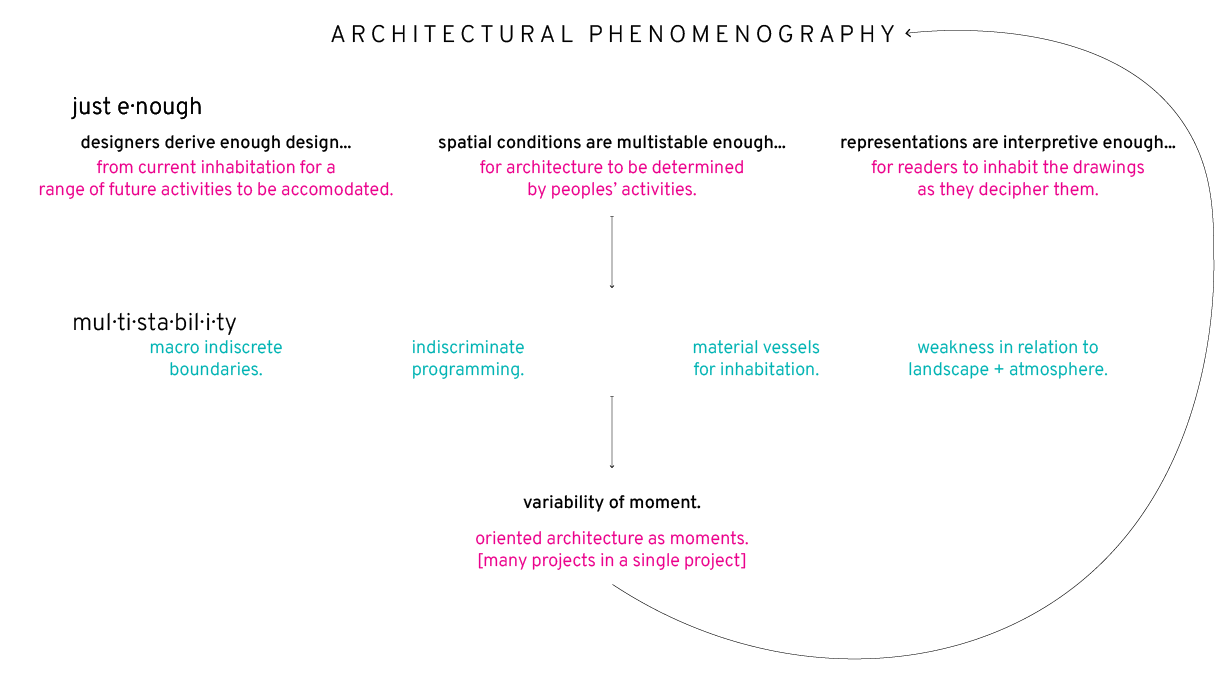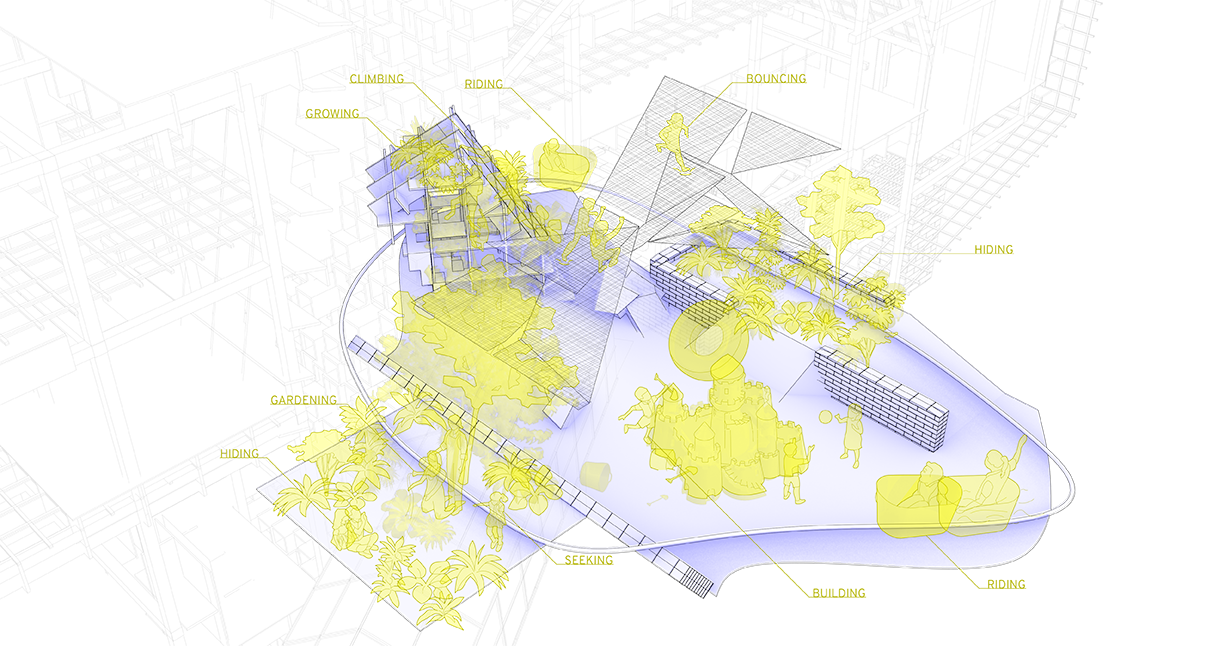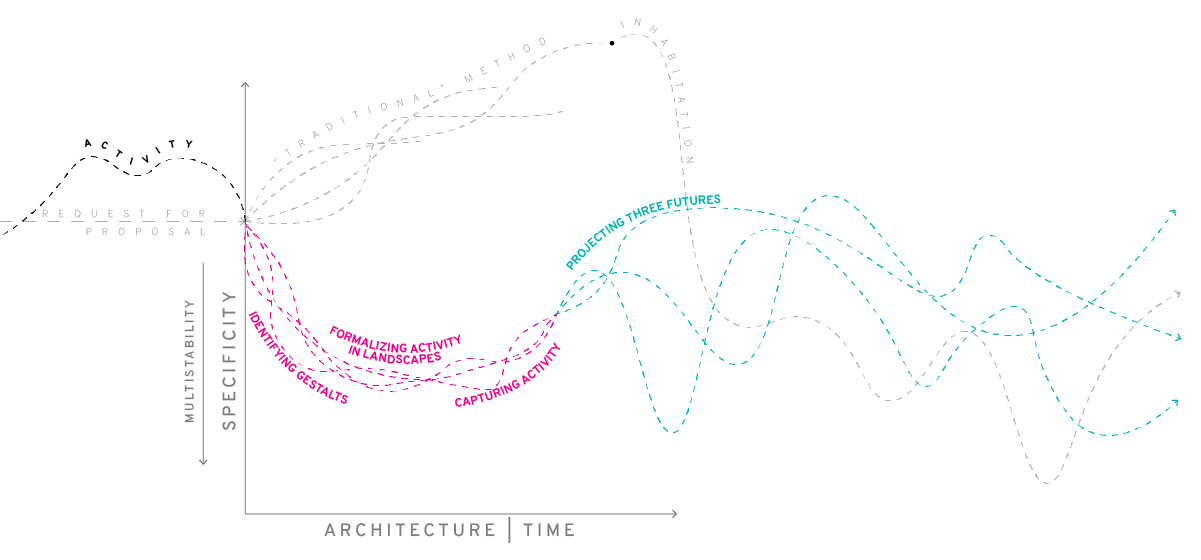MASTER OF ARCHITECTURE
Christopher Cleland—ARCC King Medal
![]()
Christopher Cleland—ARCC King Medal

About the Award
ARCC King Medal:
Acknowledging innovation, integrity, and scholarship in architectural and/or environmental design research.
Architectural Phenomenography: Just Enough To Inhabit More
What if architecture didn’t limit its users by prescribing what is to occur there? What if it were to be contingent on people’s actions?
Architecture would be weak enough to forego imposing ways of living upon us, and let our actions determine the meaning of the architecture; to really decide what something becomes as a result of us.
What we do in space is inherently a form of perceiving that space. Using activity as a form of perception, I have derived a process where designers harness what already exists experientially to imagine new spaces. This way, designers ‘design’ enough for people to choreograph their own built environment. When designers rely more on phenomenographic tools to derive design from inhabitation and when architecture is highly interpretive, it is just predetermined enough for others to determine its usage, and consequently its definition.
An architectural phenomenographic method derives meaning from lived experiences of buildings using image data sets by capturing prominent architectural moments in the form of gestalts. Composite collages concentrate the variation of activities from photographs by reconstructing those spaces and events. Monocular depth estimation (zoedepth) converts these photos into three-dimensions which are then arranged across a landscape with relation to one another.
Using the found gestalts as spatial narratives and then translating the relational landscape into ‘chrono’-orthographics and further designs, activity informs the form and program of a speculative architecture. This research assumes the form of three alternative futures in the manner of Schminke, each based on a gestalt outlined earlier: one future for physical play; one for learning and toys; and one for swimming and bathing.
This phenomenographic architecture remains weak and variable to its performing contexts to accommodate the life of its inhabitants, giving agency back to those who live with architecture. Design principles include indiscrete boundaries (superimposition), indiscriminate programming, and material vessels that can be inhabited. Just enough architecture prescribes less of the end product and allows inhabitation to choreograph the architectural construct.
In a way, inhabitants are the new ‘designers’.
I am grateful to have had the opportunity to present this thesis research at the ACSA 2024 International Conference: Inflections in Querétaro, Mexico. I am also grateful to have received an Ontario Graduate Scholarship for both years of my Master of Architecture. More importantly, thank you to the Master of Architecture program, Department of Architectural Science, and Architectural Research Centers Consortium for recognizing my work with this medal. I will forever be grateful for the opportunities I have participated in and the recognition I have received.
ARCC King Medal:
Acknowledging innovation, integrity, and scholarship in architectural and/or environmental design research.
Architectural Phenomenography: Just Enough To Inhabit More
What if architecture didn’t limit its users by prescribing what is to occur there? What if it were to be contingent on people’s actions?
Architecture would be weak enough to forego imposing ways of living upon us, and let our actions determine the meaning of the architecture; to really decide what something becomes as a result of us.
What we do in space is inherently a form of perceiving that space. Using activity as a form of perception, I have derived a process where designers harness what already exists experientially to imagine new spaces. This way, designers ‘design’ enough for people to choreograph their own built environment. When designers rely more on phenomenographic tools to derive design from inhabitation and when architecture is highly interpretive, it is just predetermined enough for others to determine its usage, and consequently its definition.
An architectural phenomenographic method derives meaning from lived experiences of buildings using image data sets by capturing prominent architectural moments in the form of gestalts. Composite collages concentrate the variation of activities from photographs by reconstructing those spaces and events. Monocular depth estimation (zoedepth) converts these photos into three-dimensions which are then arranged across a landscape with relation to one another.
Using the found gestalts as spatial narratives and then translating the relational landscape into ‘chrono’-orthographics and further designs, activity informs the form and program of a speculative architecture. This research assumes the form of three alternative futures in the manner of Schminke, each based on a gestalt outlined earlier: one future for physical play; one for learning and toys; and one for swimming and bathing.
This phenomenographic architecture remains weak and variable to its performing contexts to accommodate the life of its inhabitants, giving agency back to those who live with architecture. Design principles include indiscrete boundaries (superimposition), indiscriminate programming, and material vessels that can be inhabited. Just enough architecture prescribes less of the end product and allows inhabitation to choreograph the architectural construct.
In a way, inhabitants are the new ‘designers’.
I am grateful to have had the opportunity to present this thesis research at the ACSA 2024 International Conference: Inflections in Querétaro, Mexico. I am also grateful to have received an Ontario Graduate Scholarship for both years of my Master of Architecture. More importantly, thank you to the Master of Architecture program, Department of Architectural Science, and Architectural Research Centers Consortium for recognizing my work with this medal. I will forever be grateful for the opportunities I have participated in and the recognition I have received.






![Future for toys + learning in a sectional perspective that is designed at the building scale; [top-right] ‘Bookshelf’ as objectile (algorithm).](https://freight.cargo.site/t/original/i/48e70d6d96df907ac9487ce643399d4000d5d70c19cb0c621e472f0ce248a0b2/READING-PLAY_Elevation.png)



